The Study Blog : Tips
8 counter argument examples to help you write a strong essay.
By Evans Oct 26, 2020
A one-sided essay is like a beautiful dish with no flavor. Everyone looks at it, but nobody wants to partake of it. An essay presenting one side of a debate shows that you are not reasonable. Instead of persuading your readers, it ends up feeling like you’re just forcing an opinion on them. How do you change this? How do you make your essay interesting and persuasive? Counter argument! You heard me right. Using the counter argument is one of the best ways that you can strengthen your essay.

Before we proceed further, what exactly is a counter-argument? An academic essay means that you need to come up with a thesis, a strong one at that, and even stronger points that support that particular thesis . You also need to come up with an argument that opposes your thesis. This is what we call a counter-argument. It is basically, an argument that is against your thesis.

Are tight deadlines, clashing assignments, and unclear tasks giving you sleepless nights?
Do not panic, hire a professional essay writer today.
What is the purpose of a counter-argument?
When writing an essay, especially to persuade, you need to put yourself in the shoes of your readers. What are they likely to think about your thesis? How can they possibly argue against it? What questions might they have against the idea you are trying to sell to them? A counter-argument allows you to creatively and wisely respond to these questions. A counter-argument clears any doubts that your reader may have on your argument. It also shows them that you are the bigger person by actually addressing arguments against your thesis.
Counter argument examples
Let’s say your argument is about getting the patient to consent to it, rather than have the doctors decide on it.
A reader might argue: a patient may be too sickly to even consent for euthanasia.
Refutal: you can refute the counter-argument by proving that it is possible to get a patient in the right frame long enough to sign the consent form.
Overprotective parents
Argument: overprotective parents often treat their grown-up children like babies. As a result, these children grow to be very dependent on the parents and unable to make decisions on their own.
Counter-argument: parents have seen more than their children. Protecting them from the problems they encountered saves the children from getting hurt.
Refutal: Though parents think that shielding their grown children protects them from the dangerous world, they only end up protecting children from living. As a result, if such a child makes a mistake, it might be very hard for them to recover from it.
Getting a dog as a pet for young children
Argument: getting a dog as a pet for younger children is not a very good idea as children may not understand how to take care of the dog.
Counter-argument: having a pet teaches the children responsibility.
Rebuttal: While it is true that having a pet can teach kids how to become more responsible, the fact remains that taking care of a pet is a full-time job. A pet is not like a toy that you can discard when tired of it. Young kids may not have the stamina or the time to take care of a pet.
Exposure to technology
Argument: Technology provides children with an amazing learning experience. Children who have been exposed to technology learn pretty first how to deal and respond to different situations better than students who have no exposure to technology.
You may also like: How to write a technology essay: tips, topics, and examples
Counter argument: early exposure to entertainment and violence affects the cognitive skills of a child.
Rebuttal: Although some form of technology may affect the cognitive skills of a child, it doesn’t mean that children should be kept away from technology. There are learning programs that provide a better learning experience as compared to formal education. Doing away with technology is not the answer. The answer is controlling what children are exposed to.
Argument: taking part in elections is not only a right but a responsibility that every citizen should participate in.
Counter-argument: It is better not to vote than vote in a corrupt person.
Rebuttal: While you might feel like not taking part in the voting process keeps you from the guilt of choosing the wrong person, the truth is that you only give other people the right to choose for you. This means that if a corrupt person gets in, you’re still responsible for not voting for a better candidate.
Argument: Smoking should not be allowed on campuses.
Counter-argument: smoking is not illegal, especially to someone above 18 years old. Since it is not illegal, students should be allowed to smoke within the campus vicinity.
Rebuttal: indeed, smoking is not illegal. However, smoking on campus can prove to be fatal especially to students with health issues such as asthma. It is widely known that smoking affects not just the person holding the cigar but everyone else around them. Therefore, to keep students safe, smoking should not be allowed on campus.
Animal testing
Argument: animals should not be used as test subjects.
Counter-argument: animals happen to be the best test method for health products
Rebuttal: While it is true that over the years animals have been used as test subjects, it doesn’t change the fact that these tests often subject animals to excruciating pain. Research shows that there are better alternatives that can be used, thereby saving animals from unnecessary pain.
Cyberbullying
Argument: Cyberbullying is a serious issue and therefore it is very important to understand how to protect yourself from cyberbullies.
Counter-argument: the victims do not need to learn how to protect themselves and use the internet fearfully. The internet should be made secure for every user and all cyberbullying should be put to jail.
Rebuttal: nobody deserves to be afraid while using the internet. However, while it is a very good idea to have all cyberbullies jailed, that remains to be just a dream. This is because almost everyone can be a cyber-bully at one point or another. It, therefore, remains your responsibility to protect yourself and also learn how to handle cyberbullying.
Earn Good Grades Without Breaking a Sweat
✔ We've helped over 1000 students earn better grades since 2017. ✔ 98% of our customers are happy with our service

Final thoughts
As the examples show, a good persuasive essay should contain your thesis statement , a counter-argument, and a rebuttal of the counter-argument. This makes your essay strong, very persuasive, and with a very good flavor.
You may also like: The little secret why your friends are earning better grades
Popular services
The little secret why your friends are earning better grades.
Hire an Expert from our write my essay service and start earning good grades.
Can Someone Write My Paper for Me Online? Yes, We Can!
Research topics
Essay Topics
Popular articles
Six Proven ways to cheat Turnitin with Infographic
Understanding Philosophy of Nursing: Complete Guide With Examples
50+ Collection of the Most Controversial Argumentative Essay Topics
50+ Economics research Topics and Topic Ideas for dissertation
20+ Interesting Sociology research topics and Ideas for Your Next Project
RAISE YOUR HAND IF YOU ARE TIRED OF WRITING COLLEGE PAPERS!
Hire a professional academic writer today.
Each paper you order from us is of IMPECCABLE QUALITY and PLAGIARISM FREE
Use code PPH10 to get 10% discount. Terms and condition apply.

Ready to hire a professional essay writer?
Each paper you receive from us is plagiarism-free and will fetch you a good grade. We are proud to have helped 10,000+ students achieve their academic dreams. Enjoy our services by placing your order today.

Write my paper
Do my assignment
Essay writing help
Research paper help
College homework help
Essay writing guide
College admission essay
Writing a research paper
Paper format for writing
Terms & conditions
Privacy Policy
Cookie Policy
Money-Back Guarantee
Our services

Copyright © 2017 Paper Per Hour. All rights reserved.

Your version of Internet Explorer is either running in "Compatibility View" or is too outdated to display this site. If you believe your version of Internet Explorer is up to date, please remove this site from Compatibility View by opening Tools > Compatibility View settings (IE11) or clicking the broken page icon in your address bar (IE9, IE10)
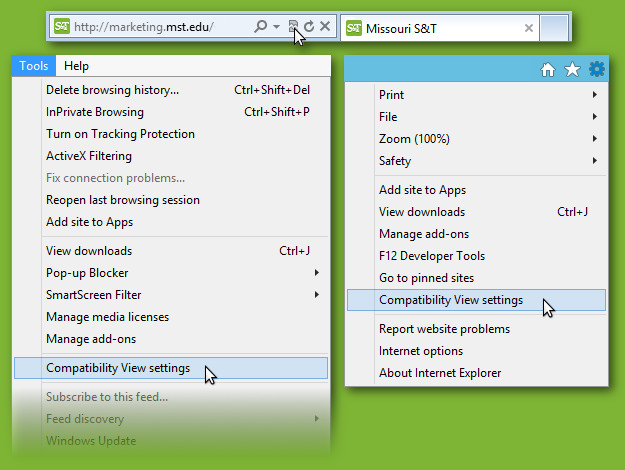
Missouri S&T Missouri S&T
- Future Students
- Current Students
- Faculty and Staff
- writingcenter.mst.edu
- Online Resources
- Writing Guides
- Counter Arguments
Writing and Communication Center
- 314 Curtis Laws Wilson Library, 400 W 14th St Rolla, MO 65409 United States
- (573) 341-4436
- [email protected]
Counter Argument
One way to strengthen your argument and demonstrate a comprehensive understanding of the issue you are discussing is to anticipate and address counter arguments, or objections. By considering opposing views, you show that you have thought things through, and you dispose of some of the reasons your audience might have for not accepting your argument. Ask yourself what someone who disagrees with you might say in response to each of the points you’ve made or about your position as a whole.
If you can’t immediately imagine another position, here are some strategies to try:
- Do some research. It may seem to you that no one could possibly disagree with the position you are taking, but someone probably has. Look around to see what stances people have and do take on the subject or argument you plan to make, so that you know what environment you are addressing.
- Talk with a friend or with your instructor. Another person may be able to play devil’s advocate and suggest counter arguments that haven’t occurred to you.
- Consider each of your supporting points individually. Even if you find it difficult to see why anyone would disagree with your central argument, you may be able to imagine more easily how someone could disagree with the individual parts of your argument. Then you can see which of these counter arguments are most worth considering. For example, if you argued “Cats make the best pets. This is because they are clean and independent,” you might imagine someone saying “Cats do not make the best pets. They are dirty and demanding.”
Once you have considered potential counter arguments, decide how you might respond to them: Will you concede that your opponent has a point but explain why your audience should nonetheless accept your argument? Or will you reject the counterargument and explain why it is mistaken? Either way, you will want to leave your reader with a sense that your argument is stronger than opposing arguments.
Two strategies are available to incorporate counter arguments into your essay:
Refutation:
Refutation seeks to disprove opposing arguments by pointing out their weaknesses. This approach is generally most effective if it is not hostile or sarcastic; with methodical, matter-of-fact language, identify the logical, theoretical, or factual flaws of the opposition.
For example, in an essay supporting the reintroduction of wolves into western farmlands, a writer might refute opponents by challenging the logic of their assumptions:
Although some farmers have expressed concern that wolves might pose a threat to the safety of sheep, cattle, or even small children, their fears are unfounded. Wolves fear humans even more than humans fear wolves and will trespass onto developed farmland only if desperate for food. The uninhabited wilderness that will become the wolves’ new home has such an abundance of food that there is virtually no chance that these shy animals will stray anywhere near humans.
Here, the writer acknowledges the opposing view (wolves will endanger livestock and children) and refutes it (the wolves will never be hungry enough to do so).
Accommodation:
Accommodation acknowledges the validity of the opposing view, but argues that other considerations outweigh it. In other words, this strategy turns the tables by agreeing (to some extent) with the opposition.
For example, the writer arguing for the reintroduction of wolves might accommodate the opposing view by writing:
Critics of the program have argued that reintroducing wolves is far too expensive a project to be considered seriously at this time. Although the reintroduction program is costly, it will only become more costly the longer it is put on hold. Furthermore, wolves will help control the population of pest animals in the area, saving farmers money on extermination costs. Finally, the preservation of an endangered species is worth far more to the environment and the ecological movement than the money that taxpayers would save if this wolf relocation initiative were to be abandoned.
This writer acknowledges the opposing position (the program is too expensive), agrees (yes, it is expensive), and then argues that despite the expense the program is worthwhile.
Some Final Hints
Don’t play dirty. When you summarize opposing arguments, be charitable. Present each argument fairly and objectively, rather than trying to make it look foolish. You want to convince your readers that you have carefully considered all sides of the issues and that you are not simply attacking or caricaturing your opponents.
Sometimes less is more. It is usually better to consider one or two serious counter arguments in some depth, rather than to address every counterargument.
Keep an open mind. Be sure that your reply is consistent with your original argument. Careful consideration of counter arguments can complicate or change your perspective on an issue. There’s nothing wrong with adopting a different perspective or changing your mind, but if you do, be sure to revise your thesis accordingly.

- Walden University
- Faculty Portal
Writing a Paper: Responding to Counterarguments
Basics of counterarguments.
When constructing an argument, it is important to consider any counterarguments a reader might make. Acknowledging the opposition shows that you are knowledgeable about the issue and are not simply ignoring other viewpoints. Addressing counterarguments also gives you an opportunity to clarify and strengthen your argument, helping to show how your argument is stronger than other arguments.
Incorporating counterarguments into your writing can seem counterintuitive at first, and some writers may be unsure how to do so. To help you incorporate counterarguments into your argument, we recommend following the steps: (a) identify, (b) investigate, (c) address, and (d) refine.
Identify the Counterarguments
First you need to identify counterarguments to your own argument. Ask yourself, based on your argument, what might someone who disagrees counter in response? You might also discover counterarguments while doing your research, as you find authors who may disagree with your argument.
For example, if you are researching the current opioid crisis in the United States, your argument might be: State governments should allocate part of the budget for addiction recovery centers in communities heavily impacted by the opioid crisis . A few counterarguments might be:
- Recovery centers are not proven to significantly help people with addiction.
- The state’s money should go to more pressing concerns such as...
- Establishing and maintaining a recovery center is too costly.
- Addicts are unworthy of assistance from the state.
Investigate the Counterarguments
Analyze the counterarguments so that you can determine whether they are valid. This may require assessing the counterarguments with the research you already have or by identifying logical fallacies . You may also need to do additional research.
In the above list, the first three counterarguments can be researched. The fourth is a moral argument and therefore can only be addressed in a discussion of moral values, which is usually outside the realm of social science research. To investigate the first, you could do a search for research that studies the effectiveness of recovery centers. For the second, you could look at the top social issues in states around the country. Is the opioid crisis the main concern or are there others? For the third, you could look for public financial data from a recovery center or interview someone who works at one to get a sense of the costs involved.
Address the Counterarguments
Address one or two counterarguments in a rebuttal. Now that you have researched the counterarguments, consider your response. In your essay, you will need to state and refute these opposing views to give more credence to your argument. No matter how you decide to incorporate the counterargument into your essay, be sure you do so with objectivity, maintaining a formal and scholarly tone .
Considerations when writing:
- Will you discredit the counteragument by bringing in contradictory research?
- Will you concede that the point is valid but that your argument still stands as the better view? (For example, perhaps it is very costly to run a recovery center, but the societal benefits offset that financial cost.)
- Placement . You can choose to place the counterargument toward the beginning of the essay, as a way to anticipate opposition, or you can place it toward the end of the essay, after you have solidly made the main points of your argument. You can also weave a counterargument into a body paragraph, as a way to quickly acknowledge opposition to a main point. Which placement is best depends on your argument, how you’ve organized your argument, and what placement you think is most effective.
- Weight . After you have addressed the counterarguments, scan your essay as a whole. Are you spending too much time on them in comparison to your main points? Keep in mind that if you linger too long on the counterarguments, your reader might learn less about your argument and more about opposing viewpoints instead.
Refine Your Argument
Considering counterarguments should help you refine your own argument, clarifying the relevant issues and your perspective. Furthermore, if you find yourself agreeing with the counterargument, you will need to revise your thesis statement and main points to reflect your new thinking.
Templates for Responding to Counterarguments
There are many ways you can incorporate counterarguments, but remember that you shouldn’t just mention the counterargument—you need to respond to it as well. You can use these templates (adapted from Graff & Birkenstein, 2009) as a starting point for responding to counterarguments in your own writing.
- The claim that _____ rests upon the questionable assumption that _____.
- X may have been true in the past, but recent research has shown that ________.
- By focusing on _____, X has overlooked the more significant problem of _____.
- Although I agree with X up to a point, I cannot accept the overall conclusion that _____.
- Though I concede that _____, I still insist that _____.
- Whereas X has provided ample evidence that ____, Y and Z’s research on ____ and ____ convinces me that _____ instead.
- Although I grant that _____, I still maintain that _____.
- While it is true that ____, it does not necessarily follow that _____.
Graff, G., & Birkenstein, C. (2009). They say/I say: The moves that matter in academic writing (2 nd ed.). Norton.
Didn't find what you need? Email us at [email protected] .
- Previous Page: Addressing Assumptions
- Next Page: Revising
- Office of Student Disability Services
Walden Resources
Departments.
- Academic Residencies
- Academic Skills
- Career Planning and Development
- Customer Care Team
- Field Experience
- Military Services
- Student Success Advising
- Writing Skills
Centers and Offices
- Center for Social Change
- Office of Academic Support and Instructional Services
- Office of Degree Acceleration
- Office of Research and Doctoral Services
- Office of Student Affairs
Student Resources
- Doctoral Writing Assessment
- Form & Style Review
- Quick Answers
- ScholarWorks
- SKIL Courses and Workshops
- Walden Bookstore
- Walden Catalog & Student Handbook
- Student Safety/Title IX
- Legal & Consumer Information
- Website Terms and Conditions
- Cookie Policy
- Accessibility
- Accreditation
- State Authorization
- Net Price Calculator
- Contact Walden
Walden University is a member of Adtalem Global Education, Inc. www.adtalem.com Walden University is certified to operate by SCHEV © 2024 Walden University LLC. All rights reserved.
How To Write A Counter Argument In An Essay
Steps of how to effectively design and write a counter argument.
Has your professor asked you to include a counterargument in your next assignment? Are you puzzled about where to start and what to write? If you wonder how to write a counter argument essay, worry not. Many students struggle to come up with the right standpoints in their papers, so we’ve decided to lend you a hand.
Expressing conflicting positions on a hot topic is a critical skill in the academic world. In short, you need a well-grounded contradicting stance with supporting facts to refute the opponent’s opinion. Keep reading to find out how.
What Is A Counterargument In An Essay – The Definition
Counter arguments should clear any doubts readers might have about your positions. Moreover, the purpose of an opposing argument is to offer a reason to disagree with the thesis statement. Whether you include it in the introduction or dedicate an entire paragraph to it, your counter argument shows that you’re aware that various views exist.
Addressing claims against your main standpoints makes you savvier, and your paper well-structured and substantiated. Since your argument essay outline will urge your readers to agree with your claim, it’s advisable to mention a reason to believe differently.
Why Are Counterarguments Important
By incorporating a contradicting standpoint in your assignment, you demonstrate that:
- You are knowledgeable about the topic and know how to back up your thoughts.
- You have researched the subject matter well and can tackle alternative views.
- You don’t underestimate opinions that clash with yours.
- You don’t stick to your perspectives blindly but are ready to discuss opposing ideas.
- You aren’t biased but have come to the ultimate standpoint through reasoning.
- You solidify your arguments and give them credibility.
How To Start A Counterargument
This segment will alert readers that a different stand from the thesis follows. So how to write a counterargument paragraph? The beginning of the denial section should explicitly or implicitly tell whoever’s reading to prepare for a contradiction. Omitting hints about the rebuttal in the paper will make it look one-sided and blunt.
So, how do you start the segment containing the counter argument? When you write your argumentative essay , ensure you include relevant starters and transitions. These may be a single word, a phrase, or an entire sentence supporting the overall statement.
Counter Argument Starters
Let’s discuss the possible phrases you can use to introduce the counter argument. Here are a few starters that inform whoever’s reading to expect a change of direction:
- However, yet, but
- Even though/although
- In spite of/despite the fact that
- On the contrary
- On the other side/hand
- A possible concern/problem is
- Conversely, in contrast
Another approach that arouses interest is to use a rhetorical question. For instance, try the following starting phrases:
- Wouldn’t it be better if…?
- But, what if…?
- Nonetheless, how can this be true…?
Similarly, you may take an indirect stance and present the counterviews of others to express your opinion. For example, say this:
- However, scientists claim that
- Yet, many people believe that
- On the other hand, students stand for
- Critics say that
Transition Words
Choosing the right counter argument starter is just a part of the equation. A coherently written assignment requires you to use transitions that make the argument flow smooth. Even the best custom essay writing service will fail its purpose if it lacks linking phrases.
Coordinating transitions ease the reading process by linking ideas into a cohesive whole. These phrases show that two things are alike or that you add extra information along the same lines. Here are a few relevant examples:
- What is more
- Not to mention
- Likewise
- Then again
- On top of that
- Not only
- Additionally
- Furthermore
Why Include A Counterargument In An Argumentative Essay?
Including a counter argument in your essay will make your written piece more convincing. Though you may think this approach will weaken your position or undermine your claim, this isn’t true. On the contrary, by doing so, you respectfully acknowledge evidence or standpoints that differ from your argument.
Some students believe a counter argument will lead the readers away from the main claim. However, any top-notch argumentative essay writer service will include it because it demonstrates the issue was elaborated from multiple perspectives. Finally, you enhance critical thinking by presenting both sides of the problem.
Example Of Counter Argument Paragraph
Below, we share a relevant example of an argument on a specific topic with guidance on avoiding writing an irrelevant counter argument.
The argument:
Many students prefer to smoke on college campuses. They often argue that authorities can’t ban smoking on campus if it isn’t illegal.
Ineffective counter argument:
However, the college management is the ultimate decision-maker and can prohibit whatever they deem harmful on campus.
This counter argument is useless because even if the college management has the right to impose bans, it can’t disregard students’ requirements on all grounds.
So, how to write an argumentative essay with a relevant counter argument? Check the suggestion below.
Effective counter argument:
Yet, second-hand smoke can harm people in the vicinity that suffer from conditions like asthma, thus putting them at risk of health deterioration.
This example will achieve its primary purpose – discuss the other perspective openly. You may disagree with this view but demonstrate you’re aware that some people might take a different standpoint. And they have every right to because no issue is one-sided. In the second example, the reader can see how students smoking on campus might harm those around.
How To Respond To A Counterargument: The Refutation
Among other things, you must address the counterviews in your written piece with a rebuttal . Stating and refuting the contradicting idea is critical if you want to give credence to your standpoint . No matter how and where you incorporate the rebuttal, do it objectively by maintaining a formal and scholarly tone.
The best approach is to oppose the counter opinion logically by considering these questions:
- Will you discredit the different perspectives by bringing in contradictory research?
- Will you say that the other point is valid but that your argument is more relevant by means of comparison?
Responding to these questions and taking a specific route will refine your stance and clarify the issues considered. Moreover, if you suddenly agree with the counter opinion, revise your statement and main points to reflect your new thinking.
Common Mistakes And Fallacies To Avoid While Writing Opposing Arguments
Keep these things in mind when you write argumentative essays, and avoid them as much as possible:
- You haven’t done research on the multiple perspectives on the topic.
- You don’t include supporting ideas for the positions against your thesis.
- You dedicate too much space and attention to contradicting reasons.
- You don’t bring up a different perspective in the introduction but keep to your opinion only.
- Your line of thought is incoherent, and you constantly switch standpoints throughout the paper.
- You use offensive or biased language to refute the opponent’s viewpoint.
- You believe the opponent’s stance is wrong and don’t give it credit.
- Besides having a strong argument , you make the counterview weak and ineffective.
- You can’t explain how your position responds to the contradicting idea.
- If you aren’t a rhetoric expert, avoid using sarcasm and satire.
Bottom Line
When writing your work, you might decide to include a sentence or a whole segment that presents a denial statement. Whatever your choice, use a specific layout to express your views clearly and accurately. It is important to remember that for urgent essay writing , the need for incorporating counterargument examples is even more critical to ensure a well-substantiated and persuasive written piece. Therefore, it is essential to consider both sides of the argument when constructing your response.
Hopefully, this post helps you understand what is a counterargument and how to write a counterargument. Provided you follow the tips outlined above, it won’t take long to polish your work. If you have any concerns about your writing assignment, always ask your teacher for support.
Do Synthesis Essays Need A Counter Argument?
Yes, ensure you include a counter argument and oppose it to justify your viewpoint. It’s best to place it in the first body segment of your synthesis essay. By doing so, you show your capacity to appreciate different opinions than yours.
Does An Argumentative Essay Need A Counter Argument?
Yes, argumentative papers should contain a well-presented contradicting idea than the one expressed in the thesis. Taking a single standpoint doesn’t add value to your work because readers with a different opinion will see it as biased and unfair.
Where Does The Counterargument Go In An Essay?
One idea is to write it in the introduction to create a contrast for the main claim. Alternatively, you may explain the contradictory opinion in one section that acknowledges the idea and then discredit it. It is often better to place it before your opinion to end the paper on a positive note that supports your perspective.
Related posts:
- 6 Step Process for Essay Writing
- How to Write an Appendix for a Research Paper: Step-by-Step Guide
- How to Write a Rhetorical Analysis Essay
- Footnotes 101: A Guide to Proper Formatting
Improve your writing with our guides

How to Write a Scholarship Essay

Definition Essay: The Complete Guide with Essay Topics and Examples

Critical Essay: The Complete Guide. Essay Topics, Examples and Outlines
Get 15% off your first order with edusson.
Connect with a professional writer within minutes by placing your first order. No matter the subject, difficulty, academic level or document type, our writers have the skills to complete it.
100% privacy. No spam ever.


- school Campus Bookshelves
- menu_book Bookshelves
- perm_media Learning Objects
- login Login
- how_to_reg Request Instructor Account
- hub Instructor Commons
- Download Page (PDF)
- Download Full Book (PDF)
- Periodic Table
- Physics Constants
- Scientific Calculator
- Reference & Cite
- Tools expand_more
- Readability
selected template will load here
This action is not available.

9.7.3: Counter Argument Paragraphs
- Last updated
- Save as PDF
- Page ID 20657

- Athena Kashyap & Erika Dyquisto
- City College of San Francisco via ASCCC Open Educational Resources Initiative

Counter-Argument Paragraphs
The purpose of a counter argument is to consider (and show that you are considering) perspectives other than your own. A counter-argument tears down other viewpoints; it does not build up your own, which you should do in separate paragraphs.
Placement of Counter-Arguments in an Essay
A counter argument can appear anywhere in the essay, but it most commonly appears:
- As part of your introduction—before you propose your thesis—where the existence of a different view is the motive for your essay. This works if your entire essay will be a counter-argument and you are not building up your own argument.
- As a section or paragraph just after your introduction, in which you lay out the expected reaction or standard position of opposing viewpoints before turning away to develop your own.
- As a quick move within a paragraph, where you imagine a counter-argument not to your main idea but to the sub-idea that the paragraph is arguing or is about to argue.
- As a section or paragraph just before the conclusion of your essay, in which you imagine what someone might object to in what you have argued. (However, this is really too late to be very effective in persuading someone to your position. It only shows you are considering other points of view.
Watch that you don't overdo it. A turn into counter argument here and there will sharpen and energize your essay, but too many such turns will have the reverse effect by obscuring your main idea or suggesting that you're ambivalent about your point of view. At the worst, it can sound like you are contradicting yourself. Writing a lead-in sentence with subordination or concession can help avoid this problem.
Example Counter-Argument
The following paragraph explains an opposing point of view to the writer's position in almost the whole paragraph. Words in bold italics explain the essential component of a counter-argument that a writer is doing in the following sentence(s).
The next paragraph is the counter-argument to the previous paragraph. Notice, however, that this count-argument does have some problems. The writer doesn't distinguish between public and private charter schools and also creates some logical fallacies in the process. Counter-arguments should be logically solid, cite sources, and argue logically.
At this point, the writer would then begin to argue their point of view with sub-claims and facts developed in a number of paragraphs to support their thesis.
If a writer is constructing an entire essay as a counter-argument, then the writer will need to fully develop multiple, well-supported arguments against the other point of view. The writer may also want to point out any logical flaws or other errors in the argument that they oppose.
Contributors and Attributions
- Revision, Adaptation, and Original Content. Provided by: Libretexts. License: CC BY-SA 4.0: Attribution.
This page most recently updated on June 6, 2020.
25 Counterargument Examples

A counterargument is a response, rebuttal, or refutation of an argument with your own argument. Its purpose is to oppose and disprove a theory that someone else has put forward.
We use counterarguments extensively in debates as well as argumentative essay writing.
When teaching essay writing, I teach my students to always present counterarguments to their opponents’ points of view. This helps them to strengthen their own argument and demonstrate awareness of potential rebuttals.
Below are some methods, with examples, that could be used – be it in essay writing, debates, or any other communication genre.
Counterargument Examples
1. empirical challenges.
An empirical challenge is, simply, a rebuttal that challenges the facts presented by the opponent, showing that their facts are wrong and yours are right.
To undermine your opponent’s set of facts, it will be your job to present facts that show that the opponent’s supposed facts are wrong, perhaps due to misreading data or cherry-picking.
Then, you would need to present concrete information, data, or evidence that negates the claim or conclusion of an opponent’s argument.
The core strength of empirical challenges is in their reliance on hard facts and numbers, which are difficult to refute without equally credible opposing data.
Example of Empirical Challenge: If your opponent argues that global warming isn’t a serious issue, an empirical challenge would be to provide scientific data or research studies showing the increase in global temperatures and the harmful effects.
See Also: Empirical Evidence Examples
2. Challenging the Relevance
Challenging the relevance means questioning whether your opponent’s argument or perspective is applicable to the discussion at hand.
This sort of counter-argument seeks to destabilize your opponent’s view by showing that, while their facts or arguments might be sound in isolation, they do not bear any relation to, or are unfit for, the topic at hand, making them irrelevant.
The power of relevance challenge lays in its ability to destabilize your opponent’s argument without needing to directly dispute the truth of their claims.
Example of Challenging the Relevance: You will often find this argument when comparing the usefulness of various research methodologies for a research project. Multiple research methods may be valid, but there’s likely one that’s best for any given study.
See Also: Relevance Examples
3. Reductio ad absurdum
Reductio ad absurdum is a latin term that means reducing to the absurd . This method involves demonstrating the absurdity of an opponent’s argument by showing its illogical or extreme consequences.
The goal is to show that if the argument were valid, it would inevitably lead to senseless or ridiculous outcomes.
The application of reductio ad absurdum is especially effective in debates or discussions where flawed logic or hyperbolic statements are used to influence the audience’s opinion, as it discredits the credibility of the other person’s argument.
Example of Reductio ad absurdum : Consider a scenario where someone argues for the total removal of all regulations on vehicle speed to improve the efficiency of transportation. You can counter this argument through reductio ad absurdum by stating, “By that logic, let’s allow cars to travel at 200 miles per hour down residential streets. After all, it would make the mail delivery much faster!” It becomes evident that permitting extremely high speeds could lead to dangerous conditions and potential for disastrous accidents.
4. Pointing Out Logical Fallacies
The strategy of pointing out logical fallacies involves identifying and highlighting flaws in your opponent’s reasoning.
In a debate or discussion, logical fallacies are often subtle errors that lead to invalid conclusions or arguments.
By identifying these fallacies, you avoid being swayed by flawed reasoning and instead promote cognizant, logical thought.
Successful use of this strategy requires a good understanding of the different kinds of logical fallacies , such as straw man fallacies, ad hominem attacks, and appeals to ignorance.
Example of Pointing Out Logical Fallacies: Consider an argument where your opponent asserts, “All cats I’ve ever seen have been aloof, so all cats must be aloof.” This is a hasty generalization fallacy, where a conclusion about all members of a group is drawn from inadequate sample size.
5. Counterexamples
A counterexample is an example that opposes or contradicts an argument or theory proposed by another.
The use of a counterexample is a practical and powerful means of rebutting an argument or theory that has been presented as absolute or universally applicable.
When you provide a singular example that contradicts your opponent’s proposed theory, it demonstrates the theory isn’t universally true and therefore, weakens their argument.
However, this tactic requires sound knowledge and a good command of subject matter to be able to identify and present valid exceptions.
Example of Counterexamples: Consider an argument where someone states that “Mammals can’t lay eggs.” A solid counterexample would be the platypus, a mammal that does lay eggs. This single example is sufficient to contradict the universal claim.
6. Using Hypotheticals
Hypothetical situations, in essence, are imagined scenarios used to refute your opponent’s point of view. It’s, in essence, an example that is plausible, but not real.
Using hypotheticals assists in clarifying the ramifications of a particular argument, policy, or theory. When a hypothetical scenario effectively illustrates the flaws or shortcomings of your opponent’s viewpoint, it can completely unsettle their position.
However, care must be taken to frame the hypotheticals reasonably and realistically, lest they distort the argument or derail the conversation.
Example of Using Hypotheticals: If someone argues that raising the minimum wage will lead to job loss, you could counter with a hypothetical that if businesses paid their employees more, those employees would have more spending power, bolstering the economy and creating more jobs.
7. Comparison and Contrast
Comparison and contrast entails directly comparing your argument to your opponent’s, showing the strength of your perspective and the weakness of the opponent’s.
This tool allows you to support your arguments or disprove your opponent’s by using existing examples or situations that illustrate your point clearly.
The technique relies heavily on the logical thinking of comparing two or more entities in a manner that is informative, convincing, and significant to the argument.
Example of Comparison and Contrast: Let’s say, for instance, you are arguing against privatization of public utilities. You could compare the rates and services of private utilities to those of public ones showing that private companies often charge more for the same services, thereby supporting your argument against privatization.
See More: Compare and Contrast Examples
8. Challenging Biases
Challenging biases involves questioning the objectivity of your opponent’s argument by pointing out the predispositions that may influence their perspective.
Biases can greatly affect the validity and reliability of an argument because they can skew the interpretation of information and hinder fair judgement.
By challenging biases, you can expose the partiality in your opponent’s argument, thereby diminishing its credibility and persuasiveness.
However, it’s important to respectfully and tactfully challenge biases to prevent the discussion from turning into a personal attack.
Example of Challenging Biases: If your opponent is a staunch supporter of a political party and they provide an argument that solely favors this party, you could challenge their bias by questioning whether their support for the party is unduly influencing their viewpoint, hence the need for them to consider the opposing perspectives.
See More: List of Different Biases
9. Ethical Dispute
Ethical disputes involve challenging your opponent’s argument based on moral values or principles.
Ethics play a crucial role in shaping people’s beliefs, attitudes, and actions. Therefore, ethical disputes can serve as powerful counterarguments, especially in debates concerning sensitive or controversial topics.
If your opponent’s position contradicts generally accepted ethical norms or values, you can point this out to weaken their argument.
Just remember, ethics can occasionally be subjective and personal, so it’s important to approach ethical disputes with sensitivity and respect.
Example of Ethical Dispute: If your opponent supports factory farming based on economic benefits, you could challenge their argument by pointing out the ethical issues related to animal welfare and the environment.
10. Challenging the Source
Challenging the source is a tactic used to question the credibility or reliability of the information used by your opponent in their argument.
This technique focuses on examining the origin of the evidence presented, probing whether the source is credible, trusted, and free from bias.
To do this, I recommend using this media literacy framework .
If the source used by your opponent is flawed, biased or unreliable, their argument loses credibility, making your position stronger.
Example of Challenging the Source: If your opponent uses an obscure blog as their primary source of their argument on a scientific topic, you could challenge the source by questioning its credibility and offering information from reputable scientific journals instead.
See More: Good Sources for Essay Writing
A Full List of Methods for Counterargument
- Empirical challenges
- Challenging the relevance
- Reductio ad absurdum
- Pointing out logical fallacies
- Counterexamples
- Using hypotheticals
- Comparison and contrast
- Challenging biases
- Ethical dispute
- Challenging the source
- Questioning assumptions
- Slippery slope argument
- Challenging a false dichtomy
- Historical Precedent
- Anecdotal Evidence
- Challenging the Definition
- Socratic Questioning
- Highlighting Unintended Consequences
- Appeal to Emotion
- Challenging the Frame
- Highlighting Inconsistencies
- Challenging Completeness
- Temporal Challenge
- Offering alternative explanations
- Exposing oversimplifications
- Appeal to authority
Counterargument is an essential skill for debaters and essay writers. You need to be able to know and understand strategies for countering the arguments of your opponents to position your argument in the best light possible. To do this, we have to vectors of attack: First, you can undermine their arguments and demonstrate the flaws. Second, you can present your argument as stronger.
The key, however, is to ensure your arguments are as airtight and foolproof as possible to prevent effective rebuttals to your own counterarguments!

Chris Drew (PhD)
Dr. Chris Drew is the founder of the Helpful Professor. He holds a PhD in education and has published over 20 articles in scholarly journals. He is the former editor of the Journal of Learning Development in Higher Education. [Image Descriptor: Photo of Chris]
- Chris Drew (PhD) https://helpfulprofessor.com/author/chris-drew-phd/ 5 Top Tips for Succeeding at University
- Chris Drew (PhD) https://helpfulprofessor.com/author/chris-drew-phd/ 50 Durable Goods Examples
- Chris Drew (PhD) https://helpfulprofessor.com/author/chris-drew-phd/ 100 Consumer Goods Examples
- Chris Drew (PhD) https://helpfulprofessor.com/author/chris-drew-phd/ 30 Globalization Pros and Cons
Leave a Comment Cancel Reply
Your email address will not be published. Required fields are marked *
Counterarguments
A counterargument involves acknowledging standpoints that go against your argument and then re-affirming your argument. This is typically done by stating the opposing side’s argument, and then ultimately presenting your argument as the most logical solution. The counterargument is a standard academic move that is used in argumentative essays because it shows the reader that you are capable of understanding and respecting multiple sides of an argument.
Counterargument in two steps
Respectfully acknowledge evidence or standpoints that differ from your argument.
Refute the stance of opposing arguments, typically utilizing words like “although” or “however.”
In the refutation, you want to show the reader why your position is more correct than the opposing idea.
Where to put a counterargument
Can be placed within the introductory paragraph to create a contrast for the thesis statement.
May consist of a whole paragraph that acknowledges the opposing view and then refutes it.
- Can be one sentence acknowledgements of other opinions followed by a refutation.
Why use a counterargument?
Some students worry that using a counterargument will take away from their overall argument, but a counterargument may make an essay more persuasive because it shows that the writer has considered multiple sides of the issue. Barnet and Bedau (2005) propose that critical thinking is enhanced through imagining both sides of an argument. Ultimately, an argument is strengthened through a counterargument.
Examples of the counterargument structure
- Argument against smoking on campus: Admittedly, many students would like to smoke on campus. Some people may rightly argue that if smoking on campus is not illegal, then it should be permitted; however, second-hand smoke may cause harm to those who have health issues like asthma, possibly putting them at risk.
- Argument against animal testing: Some people argue that using animals as test subjects for health products is justifiable. To be fair, animal testing has been used in the past to aid the development of several vaccines, such as small pox and rabies. However, animal testing for beauty products causes unneeded pain to animals. There are alternatives to animal testing. Instead of using animals, it is possible to use human volunteers. Additionally, Carl Westmoreland (2006) suggests that alternative methods to animal research are being developed; for example, researchers are able to use skin constructed from cells to test cosmetics. If alternatives to animal testing exist, then the practice causes unnecessary animal suffering and should not be used.
Harvey, G. (1999). Counterargument. Retrieved from writingcenter.fas.harvard.edu/pages/counter- argument
Westmoreland, C. (2006; 2007). “Alternative Tests and the 7th Amendment to the Cosmetics Directive.” Hester, R. E., & Harrison, R. M. (Ed.) Alternatives to animal testing (1st Ed.). Cambridge: Royal Society of Chemistry.
Barnet, S., Bedau, H. (Eds.). (2006). Critical thinking, reading, and writing . Boston, MA: Bedford/St. Martin’s.
Contributor: Nathan Lachner
Table of Contents
Ai, ethics & human agency, collaboration, information literacy, writing process, counterarguments – rebuttal – refutation.
- © 2023 by Roberto León - Georgia College & State University
Ignoring what your target audience thinks and feels about your argument isn't a recipe for success. Instead, engage in audience analysis : ask yourself, "How is your target audience likely to respond to your propositions? What counterarguments -- arguments about your argument -- will your target audience likely raise before considering your propositions?"

Counterargument Definition
C ounterargument refers to an argument given in response to another argument that takes an alternative approach to the issue at hand.
C ounterargument may also be known as rebuttal or refutation .
Related Concepts
Audience Awareness ; Authority (in Speech and Writing) ; Critical Literacy ; Ethos ; Openness ; Researching Your Audience
Guide to Counterarguments in Writing Studies
Counterarguments are a topic of study in Writing Studies as
- Rhetors engage in rhetorical reasoning : They analyze the rebuttals their target audiences may have to their claims , interpretations , propositions, and proposals
- Rhetors may develop counterarguments by questioning a rhetor’s backing , data , qualifiers, and/or warrants
- Rhetors begin arguments with sincere summaries of counterarguments
- a strategy of Organization .
Learning about the placement of counterarguments in Toulmin Argument , Arisotelian Argument , and Rogerian Argument will help you understand when you need to introduce counterarguments and how thoroughly you need to address them.

Why Do Counterarguments Matter?
If your goal is clarity and persuasion, you cannot ignore what your target audience thinks, feels, and does about the argument. To communicate successfully with audiences, rhetors need to engage in audience analysis : they need to understand the arguments against their argument that the audience may hold.
Imagine that you are scrolling through your social media feed when you see a post from an old friend. As you read, you immediately feel that your friend’s post doesn’t make sense. “They can’t possibly believe that!” you tell yourself. You quickly reply “I’m not sure I agree. Why do you believe that?” Your friend then posts a link to an article and tells you to see for yourself.
There are many ways to analyze your friend’s social media post or the professor’s article your friend shared. You might, for example, evaluate the professor’s article by using the CRAAP Test or by conducting a rhetorical analysis of their aims and ethos . After engaging in these prewriting heuristics to get a better sense of what your friend knows and feels about the topic at hand, you may feel more prepared to respond to their arguments and also sense how they might react to your post.
Toulmin Counterarguments
There’s more than one way to counter an argument.
In Toulmin Argument , a counterargument can be made against the writer’s claim by questioning their backing , data , qualifiers, and/or warrants . For example, let’s say we wrote the following argument:
“Social media is bad for you (claim) because it always (qualifier) promotes an unrealistic standard of beauty (backing). In this article, researchers found that most images were photoshopped (data). Standards should be realistic; if they are not, those standards are bad (warrant).”
Besides noting we might have a series of logical fallacies here, counterarguments and dissociations can be made against each of these parts:
- Against the qualifier: Social media does not always promote unrealistic standards.
- Against the backing : Social media presents but does not promote unrealistic standards.
- Against the data : This article focuses on Instagram; these findings are not applicable to Twitter.
- Against the warrant : How we approach standards matters more than the standards themselves; standards do not need to be realistic, but rather we need to be realistic about how we approach standards.
In generating and considering counterarguments and conditions of rebuttal, it is important to consider how we approach alternative views. Alternative viewpoints are opportunities not only to strengthen and contrast our own arguments with those of others; alternative viewpoints are also opportunities to nuance and develop our own arguments.
Let us continue to look at our social media argument and potential counterarguments. We might prepare responses to each of these potential counterarguments, anticipating the ways in which our audience might try to shift how we frame this situation. However, we might also concede that some of these counterarguments actually have good points.
For example, we might still believe that social media is bad, but perhaps we also need to consider more about
- What factors make it worse (nuance the qualifier)?
- Whether or not social media is a neutral tool or whether algorithms take advantage of our baser instincts (nuance the backing )
- Whether this applies to all social media or whether we want to focus on just one social media platform (nuance the data )
- How should we approach social standards (nuance the warrant )?
Identifying counterarguments can help us strengthen our arguments by helping us recognize the complexity of the issue at hand.
Neoclassical Argument – Aristotelian Argument
Learn how to compose a counterargument passage or section.
While Toulmin Argument focuses on the nuts and bolts of argumentation, a counterargument can also act as an entire section of an Aristotelian Argument . This section typically comes after you have presented your own lines of argument and evidence .
This section typically consists of two rhetorical moves :
Examples of Counterarguments
By introducing counterarguments, we show we are aware of alternative viewpoints— other definitions, explanations, meanings, solutions, etc. We want to show that we are good listeners and aren’t committing the strawman fallacy . We also concede some of the alternative viewpoints that we find most persuasive. By making concessions, we can show that we are reasonable ( ethos ) and that we are listening . Rogerian Argument is an example of building listening more fully into our writing.
Using our social media example, we might write:
I recognize that in many ways social media is only as good as the content that people upload to it. As Professor X argues, social media amplifies both the good and the bad of human nature.
Once we’ve shown that we understand and recognize good arguments when we see them, we put forward our response to the counterclaim. In our response, we do not simply dismiss alternative viewpoints, but provide our own backing, data, and warrants to show that we, in fact, have the more compelling position.
To counter Professor X’s argument, we might write:
At the same time, there are clear instances where social media amplifies the bad over the good by design. While content matters, the design of social media is only as good as the people who created it.
Through conceding and countering, we can show that we recognize others’ good points and clarify where we stand in relation to others’ arguments.
Counterarguments and Organization
Learn when and how to weave counterarguments into your texts.
As we write, it is also important to consider the extent to which we will respond to counterarguments. If we focus too much on counterarguments, we run the risk of downplaying our own contributions. If we focus too little on counterarguments, we run the risk of seeming aloof and unaware of reality. Ideally, we will be somewhere in between these two extremes.
There are many places to respond to counterarguments in our writing. Where you place your counterarguments will depend on the rhetorical situation (ex: audience , purpose, subject ), your rhetorical stance (how you want to present yourself), and your sense of kairos . Here are some common choices based on a combination of these rhetorical situation factors:
- If a counterargument is well-established for your audience, you may want to respond to that counterargument earlier in your essay, clearing the field and creating space for you to make your own arguments. An essay about gun rights, for example, would need to make it clear very quickly that it is adding something new to this old debate. Doing so shows your audience that you are very aware of their needs.
- If a counterargument is especially well-established for your audience and you simply want to prove that it is incorrect rather than discuss another solution, you might respond to it point by point, structuring your whole essay as an extended refutation. Fact-checking and commentary articles often make this move. Responding point by point shows that you take the other’s point of view seriously.
- If you are discussing something relatively unknown or new to your audience (such as a problem with black mold in your dormitory), you might save your response for after you have made your points. Including alternative viewpoints even here shows that you are aware of the situation and have nothing to hide.
Whichever you choose, remember that counterarguments are opportunities to ethically engage with alternative viewpoints and your audience.
The following questions can guide you as you begin to think about counterarguments:
- What is your argument ? What alternative positions might exist as counterarguments to your argument?
- How can considering counterarguments strengthen your argument?
- Given possible counterarguments, what points might you reconsider or concede?
- To what extent might you respond to counterarguments in your essay so that they can create and respond to the rhetorical situation ?
- Where might you place your counterarguments in your essay?
- What might including counterarguments do for your ethos ?
Recommended Resources
- Sweetland Center for Writing (n.d.). “ How Do I Incorporate a Counterargument? ” University of Michigan.
- The Writing Center (n.d.) “ All About Counterarguments .” George Mason University.
- Lachner, N. (n.d.). “ Counterarguments .” University of Nevada Reno, University Writing and Speaking Center.
- Jeffrey, R. (n.d.). “ Questions for Thinking about Counterarguments .” In M. Gagich and E. Zickel, A Guide to Rhetoric, Genre, and Success in First-Year Writing.
- Kause, S. (2011). “ On the Other Hand: The Role of Antithetical Writing in First Year Composition Courses .” Writing Spaces Vol. 2.
- Burton, G. “ Refutatio .” Silvae Rhetoricae.
Toulmin, S. (1958). The Uses of Argument. Cambridge University Press.
Perelman, C. and Olbrechts-Tyteca, L. (1971). “The Dissociation of Concepts”; “The Interaction of Arguments,” in The New Rhetoric: A Treatise on Argumentation (pp. 411-459, 460-508), University of Notre Dame Press.
Mozafari, C. (2018). “Crafting Counterarguments,” in Fearless Writing: Rhetoric, Inquiry, Argument (pp. 333-337), MacMillian Learning

Brevity - Say More with Less

Clarity (in Speech and Writing)

Coherence - How to Achieve Coherence in Writing

Flow - How to Create Flow in Writing

Inclusivity - Inclusive Language

The Elements of Style - The DNA of Powerful Writing

Suggested Edits
- Please select the purpose of your message. * - Corrections, Typos, or Edits Technical Support/Problems using the site Advertising with Writing Commons Copyright Issues I am contacting you about something else
- Your full name
- Your email address *
- Page URL needing edits *
- Phone This field is for validation purposes and should be left unchanged.
Other Topics:

Citation - Definition - Introduction to Citation in Academic & Professional Writing
- Joseph M. Moxley
Explore the different ways to cite sources in academic and professional writing, including in-text (Parenthetical), numerical, and note citations.

Collaboration - What is the Role of Collaboration in Academic & Professional Writing?
Collaboration refers to the act of working with others or AI to solve problems, coauthor texts, and develop products and services. Collaboration is a highly prized workplace competency in academic...

Genre may reference a type of writing, art, or musical composition; socially-agreed upon expectations about how writers and speakers should respond to particular rhetorical situations; the cultural values; the epistemological assumptions...

Grammar refers to the rules that inform how people and discourse communities use language (e.g., written or spoken English, body language, or visual language) to communicate. Learn about the rhetorical...

Information Literacy - Discerning Quality Information from Noise
Information Literacy refers to the competencies associated with locating, evaluating, using, and archiving information. In order to thrive, much less survive in a global information economy — an economy where information functions as a...

Mindset refers to a person or community’s way of feeling, thinking, and acting about a topic. The mindsets you hold, consciously or subconsciously, shape how you feel, think, and act–and...

Rhetoric: Exploring Its Definition and Impact on Modern Communication
Learn about rhetoric and rhetorical practices (e.g., rhetorical analysis, rhetorical reasoning, rhetorical situation, and rhetorical stance) so that you can strategically manage how you compose and subsequently produce a text...

Style, most simply, refers to how you say something as opposed to what you say. The style of your writing matters because audiences are unlikely to read your work or...

The Writing Process - Research on Composing
The writing process refers to everything you do in order to complete a writing project. Over the last six decades, researchers have studied and theorized about how writers go about...

Writing Studies
Writing studies refers to an interdisciplinary community of scholars and researchers who study writing. Writing studies also refers to an academic, interdisciplinary discipline – a subject of study. Students in...
Featured Articles

Academic Writing – How to Write for the Academic Community

Professional Writing – How to Write for the Professional World

Credibility & Authority – How to Be Credible & Authoritative in Speech & Writing

English Current
ESL Lesson Plans, Tests, & Ideas
- North American Idioms
- Business Idioms
- Idioms Quiz
- Idiom Requests
- Proverbs Quiz & List
- Phrasal Verbs Quiz
- Basic Phrasal Verbs
- North American Idioms App
- A(n)/The: Help Understanding Articles
- The First & Second Conditional
- The Difference between 'So' & 'Too'
- The Difference between 'a few/few/a little/little'
- The Difference between "Other" & "Another"
- Check Your Level
- English Vocabulary
- Verb Tenses (Intermediate)
- Articles (A, An, The) Exercises
- Prepositions Exercises
- Irregular Verb Exercises
- Gerunds & Infinitives Exercises
- Discussion Questions
- Speech Topics
- Argumentative Essay Topics
- Top-rated Lessons
- Intermediate
- Upper-Intermediate
- Reading Lessons
- View Topic List
- Expressions for Everyday Situations
- Travel Agency Activity
- Present Progressive with Mr. Bean
- Work-related Idioms
- Adjectives to Describe Employees
- Writing for Tone, Tact, and Diplomacy
- Speaking Tactfully
- Advice on Monetizing an ESL Website
- Teaching your First Conversation Class
- How to Teach English Conversation
- Teaching Different Levels
- Teaching Grammar in Conversation Class
- Members' Home
- Update Billing Info.
- Cancel Subscription
- North American Proverbs Quiz & List
- North American Idioms Quiz
- Idioms App (Android)
- 'Be used to'" / 'Use to' / 'Get used to'
- Ergative Verbs and the Passive Voice
- Keywords & Verb Tense Exercises
- Irregular Verb List & Exercises
- Non-Progressive (State) Verbs
- Present Perfect vs. Past Simple
- Present Simple vs. Present Progressive
- Past Perfect vs. Past Simple
- Subject Verb Agreement
- The Passive Voice
- Subject & Object Relative Pronouns
- Relative Pronouns Where/When/Whose
- Commas in Adjective Clauses
- A/An and Word Sounds
- 'The' with Names of Places
- Understanding English Articles
- Article Exercises (All Levels)
- Yes/No Questions
- Wh-Questions
- How far vs. How long
- Affect vs. Effect
- A few vs. few / a little vs. little
- Boring vs. Bored
- Compliment vs. Complement
- Die vs. Dead vs. Death
- Expect vs. Suspect
- Experiences vs. Experience
- Go home vs. Go to home
- Had better vs. have to/must
- Have to vs. Have got to
- I.e. vs. E.g.
- In accordance with vs. According to
- Lay vs. Lie
- Make vs. Do
- In the meantime vs. Meanwhile
- Need vs. Require
- Notice vs. Note
- 'Other' vs 'Another'
- Pain vs. Painful vs. In Pain
- Raise vs. Rise
- So vs. Such
- So vs. So that
- Some vs. Some of / Most vs. Most of
- Sometimes vs. Sometime
- Too vs. Either vs. Neither
- Weary vs. Wary
- Who vs. Whom
- While vs. During
- While vs. When
- Wish vs. Hope
- 10 Common Writing Mistakes
- 34 Common English Mistakes
- First & Second Conditionals
- Comparative & Superlative Adjectives
- Determiners: This/That/These/Those
- Check Your English Level
- Grammar Quiz (Advanced)
- Vocabulary Test - Multiple Questions
- Vocabulary Quiz - Choose the Word
- Verb Tense Review (Intermediate)
- Verb Tense Exercises (All Levels)
- Conjunction Exercises
- List of Topics
- Business English
- Games for the ESL Classroom
- Pronunciation
- Teaching Your First Conversation Class
- How to Teach English Conversation Class
Argumentative Essays: The Counter-Argument & Refutation
An argumentative essay presents an argument for or against a topic. For example, if your topic is working from home , then your essay would either argue in favor of working from home (this is the for side) or against working from home.
Like most essays, an argumentative essay begins with an introduction that ends with the writer's position (or stance) in the thesis statement .
Introduction Paragraph
(Background information....)
- Thesis statement : Employers should give their workers the option to work from home in order to improve employee well-being and reduce office costs.
This thesis statement shows that the two points I plan to explain in my body paragraphs are 1) working from home improves well-being, and 2) it allows companies to reduce costs. Each topic will have its own paragraph. Here's an example of a very basic essay outline with these ideas:
- Background information
Body Paragraph 1
- Topic Sentence : Workers who work from home have improved well-being .
- Evidence from academic sources
Body Paragraph 2
- Topic Sentence : Furthermore, companies can reduce their expenses by allowing employees to work at home .
- Summary of key points
- Restatement of thesis statement
Does this look like a strong essay? Not really . There are no academic sources (research) used, and also...
You Need to Also Respond to the Counter-Arguments!
The above essay outline is very basic. The argument it presents can be made much stronger if you consider the counter-argument , and then try to respond (refute) its points.
The counter-argument presents the main points on the other side of the debate. Because we are arguing FOR working from home, this means the counter-argument is AGAINST working from home. The best way to find the counter-argument is by reading research on the topic to learn about the other side of the debate. The counter-argument for this topic might include these points:
- Distractions at home > could make it hard to concentrate
- Dishonest/lazy people > might work less because no one is watching
Next, we have to try to respond to the counter-argument in the refutation (or rebuttal/response) paragraph .
The Refutation/Response Paragraph
The purpose of this paragraph is to address the points of the counter-argument and to explain why they are false, somewhat false, or unimportant. So how can we respond to the above counter-argument? With research !
A study by Bloom (2013) followed workers at a call center in China who tried working from home for nine months. Its key results were as follows:
- The performance of people who worked from home increased by 13%
- These workers took fewer breaks and sick-days
- They also worked more minutes per shift
In other words, this study shows that the counter-argument might be false. (Note: To have an even stronger essay, present data from more than one study.) Now we have a refutation.
Where Do We Put the Counter-Argument and Refutation?
Commonly, these sections can go at the beginning of the essay (after the introduction), or at the end of the essay (before the conclusion). Let's put it at the beginning. Now our essay looks like this:
Counter-argument Paragraph
- Dishonest/lazy people might work less because no one is watching
Refutation/Response Paragraph
- Study: Productivity increased by 14%
- (+ other details)
Body Paragraph 3
- Topic Sentence : In addition, people who work from home have improved well-being .
Body Paragraph 4
The outline is stronger now because it includes the counter-argument and refutation. Note that the essay still needs more details and research to become more convincing.

Working from home may increase productivity.
Extra Advice on Argumentative Essays
It's not a compare and contrast essay.
An argumentative essay focuses on one topic (e.g. cats) and argues for or against it. An argumentative essay should not have two topics (e.g. cats vs dogs). When you compare two ideas, you are writing a compare and contrast essay. An argumentative essay has one topic (cats). If you are FOR cats as pets, a simplistic outline for an argumentative essay could look something like this:
- Thesis: Cats are the best pet.
- are unloving
- cause allergy issues
- This is a benefit > Many working people do not have time for a needy pet
- If you have an allergy, do not buy a cat.
- But for most people (without allergies), cats are great
- Supporting Details
Use Language in Counter-Argument That Shows Its Not Your Position
The counter-argument is not your position. To make this clear, use language such as this in your counter-argument:
- Opponents might argue that cats are unloving.
- People who dislike cats would argue that cats are unloving.
- Critics of cats could argue that cats are unloving.
- It could be argued that cats are unloving.
These underlined phrases make it clear that you are presenting someone else's argument , not your own.
Choose the Side with the Strongest Support
Do not choose your side based on your own personal opinion. Instead, do some research and learn the truth about the topic. After you have read the arguments for and against, choose the side with the strongest support as your position.
Do Not Include Too Many Counter-arguments
Include the main (two or three) points in the counter-argument. If you include too many points, refuting these points becomes quite difficult.
If you have any questions, leave a comment below.
- Matthew Barton / Creator of Englishcurrent.com
Additional Resources :
- Writing a Counter-Argument & Refutation (Richland College)
- Language for Counter-Argument and Refutation Paragraphs (Brown's Student Learning Tools)
EnglishCurrent is happily hosted on Dreamhost . If you found this page helpful, consider a donation to our hosting bill to show your support!
23 comments on “ Argumentative Essays: The Counter-Argument & Refutation ”
Thank you professor. It is really helpful.
Can you also put the counter argument in the third paragraph
It depends on what your instructor wants. Generally, a good argumentative essay needs to have a counter-argument and refutation somewhere. Most teachers will probably let you put them anywhere (e.g. in the start, middle, or end) and be happy as long as they are present. But ask your teacher to be sure.
Thank you for the information Professor
how could I address a counter argument for “plastic bags and its consumption should be banned”?
For what reasons do they say they should be banned? You need to address the reasons themselves and show that these reasons are invalid/weak.
Thank you for this useful article. I understand very well.
Thank you for the useful article, this helps me a lot!
Thank you for this useful article which helps me in my study.
Thank you, professor Mylene 102-04
it was very useful for writing essay
Very useful reference body support to began writing a good essay. Thank you!
Really very helpful. Thanks Regards Mayank
Thank you, professor, it is very helpful to write an essay.
It is really helpful thank you
It was a very helpful set of learning materials. I will follow it and use it in my essay writing. Thank you, professor. Regards Isha
Thanks Professor
This was really helpful as it lays the difference between argumentative essay and compare and contrast essay.. Thanks for the clarification.
This is such a helpful guide in composing an argumentative essay. Thank you, professor.
This was really helpful proof, thankyou!
Thanks this was really helpful to me
This was very helpful for us to generate a good form of essay
thank you so much for this useful information.
Leave a Reply Cancel reply
Your email address will not be published. Required fields are marked *

Counter Argument

In the realm of persuasive writing, crafting a strong argument is essential to sway the audience’s perspective. However, to truly excel in the art of rhetoric, one must also be adept at presenting counterarguments. In this article, we will delve into the intricacies of counter-arguments, exploring their definition, step-by-step guide, and addressing frequently asked questions. Whether you’re an aspiring writer or seeking to enhance your argumentative skills, this comprehensive resource will equip you with the necessary tools to construct compelling counter-arguments.
1. Argumentative Essay Example
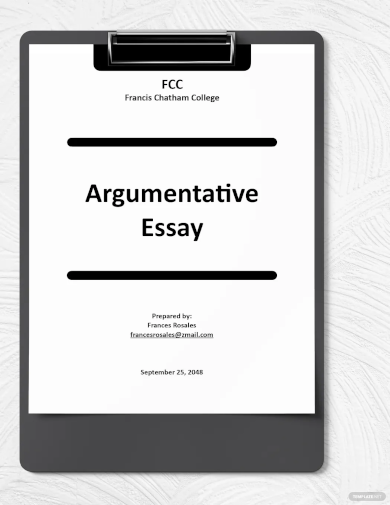
2. Simple Argumentative Essay Example
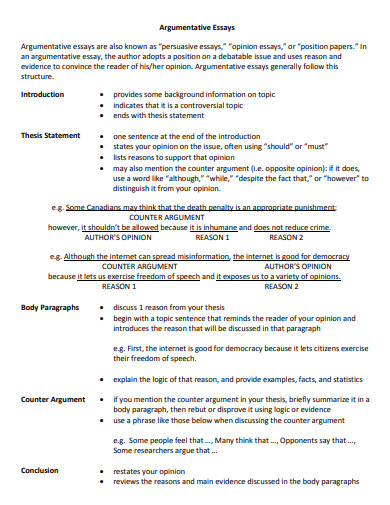
Size: 200 KB
3. Counter Argument Essay Example

Size: 167 KB
4. Persuasive Essay Example
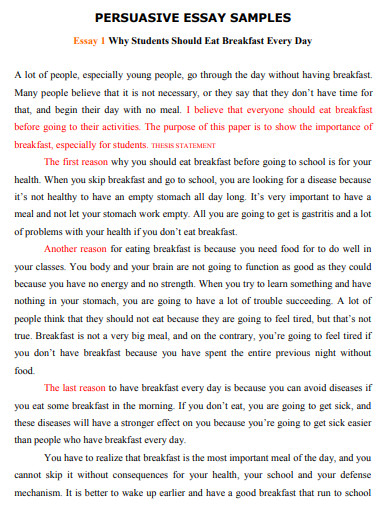
Size: 205 KB
5. Counter Argument Outline Example

Size: 392 KB
6. Counter Argument Rebuttal Example

Size: 204 KB
7. Counter Argument Paragraph Example
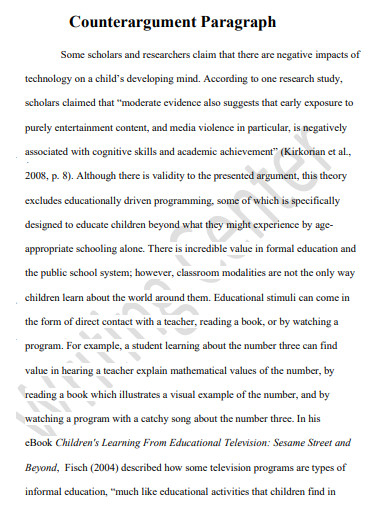
Size: 189 KB
8. Counter Argument Starters Example

Size: 72 KB
9. Counter Argument Concession Example
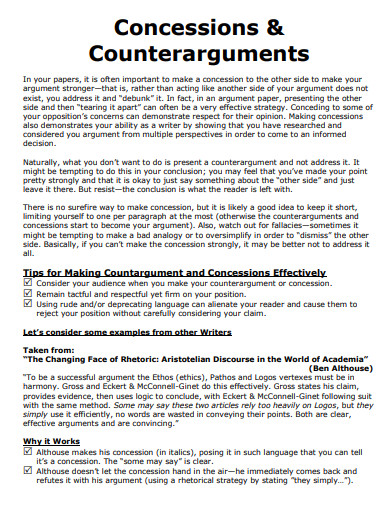
Size: 120 KB
10. Counter Argument Debate Example
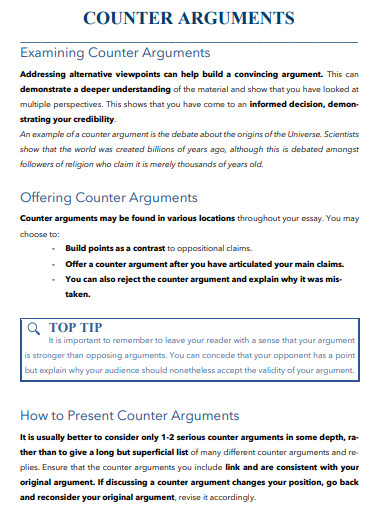
Size: 139 KB
11. Position Paper Example
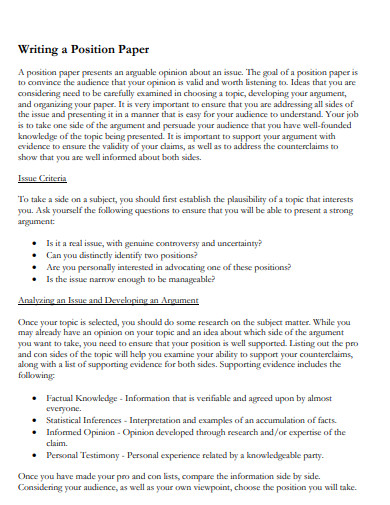
Size: 73 KB
12. Counter Argument Transition Example

Size: 188 KB
13. Counter Argument Research Paper Example
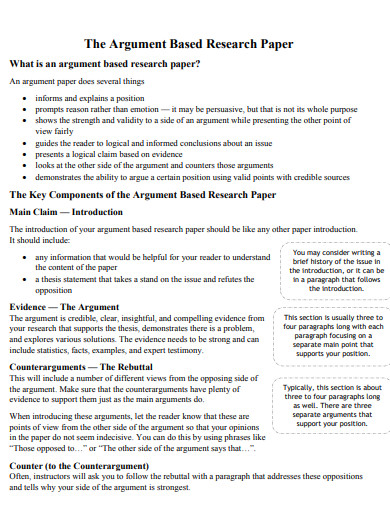
Size: 282 KB
14. Counter Argument Thesis Statement Example
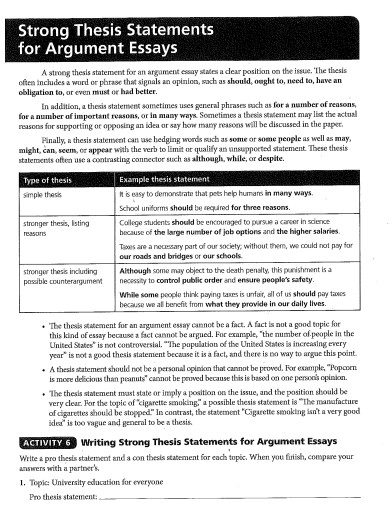
15. Counter Argument Essay Structure Example
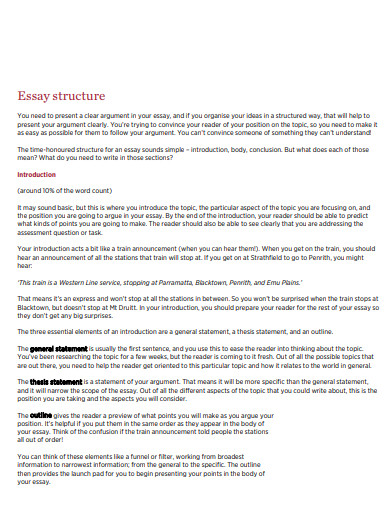
Size: 152 KB
16. Counter Argument Opinion Essay Example
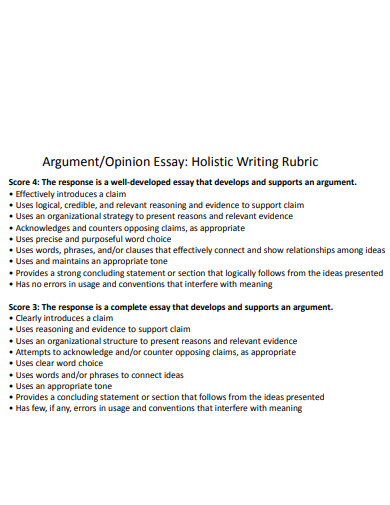
Size: 175 KB
17. Counter Argument Synthesis Essay Example

Size: 96 KB
18. Counter Argument Writing Example
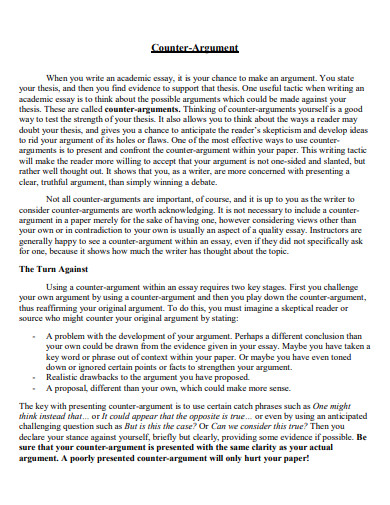
Size: 14 KB
19. Counter Argument Social Media Example

Size: 207 KB
20. Counter Argument Counterclaim Example
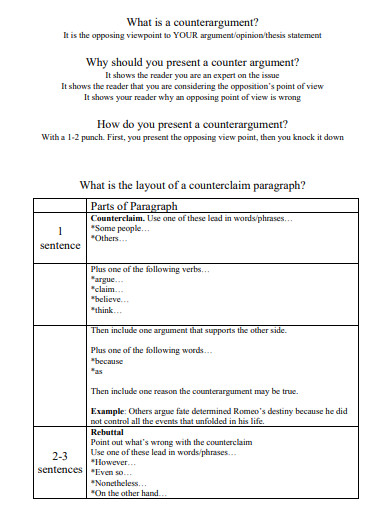
Size: 160 KB
21. Counter Argument Format
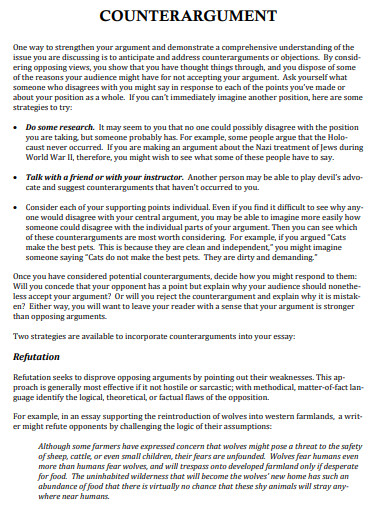
Size: 130 KB
22. Teaching Counter Argument Example
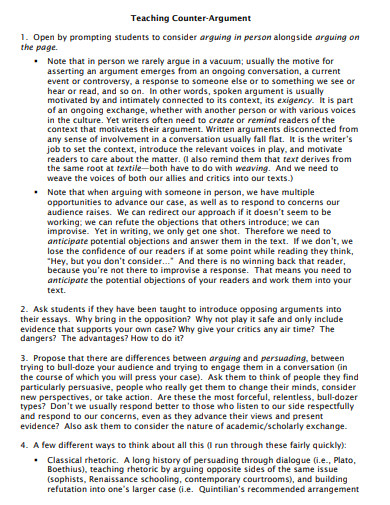
Size: 119 KB
23. Counter Argument Example

Size: 404 KB
24. Counter Argument Refutation Example

Size: 142 KB
25. Counter Argument Activity Example

Size: 12 KB
26. Simple Counter Argument Example
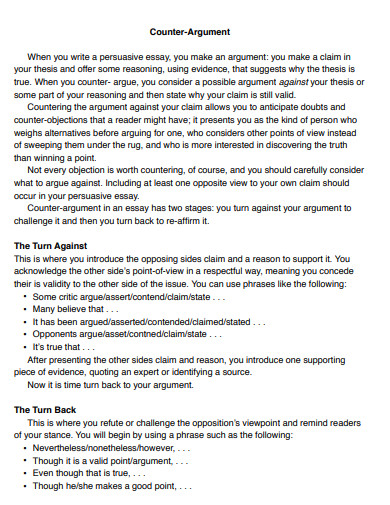
Size: 41 KB
27. Counter Argument Worksheet Example
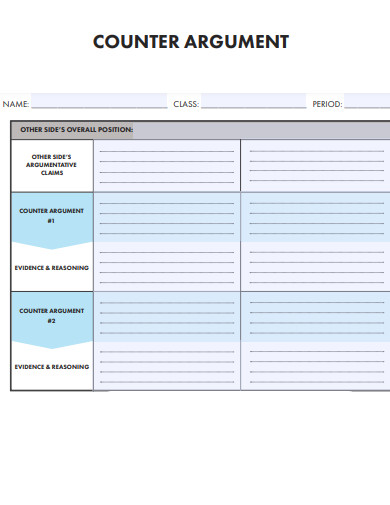
Size: 24 KB
28. Printable Counter Argument Example
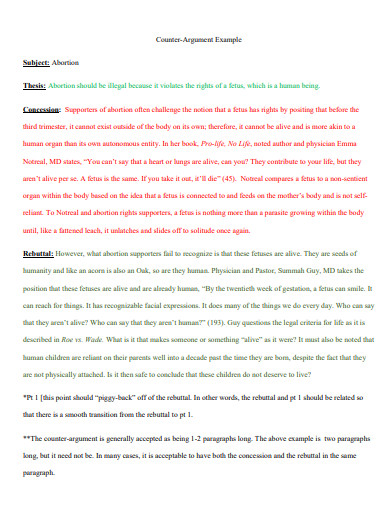
Size: 106 KB
29. Counter Argument Conclusion Example
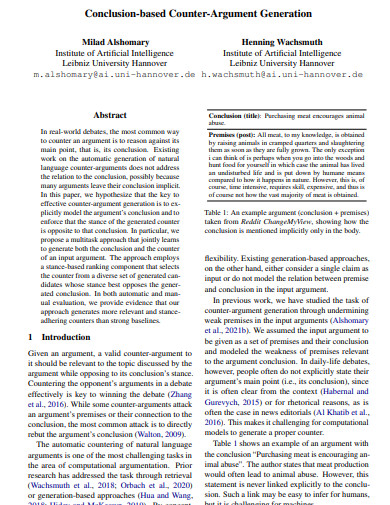
Size: 920 KB
30. Counter Argument in PDF
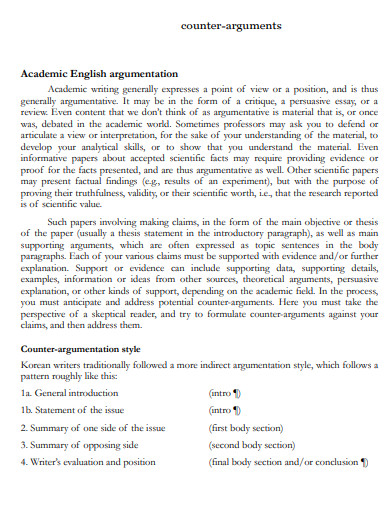
Size: 112 KB
What is a Counter Argument?
A counter-argument, often employed in an argument essay , is a powerful literary device used to challenge and refute opposing viewpoints. It serves as a potent means to anticipate and address potential objections that may arise in the minds of the audience. By acknowledging alternative perspectives and presenting well-reasoned counterpoints, writers can strengthen their own argument, adding depth and credibility to their discourse. Effective counterarguments showcase the writer’s ability to analyze multiple angles, fostering a more comprehensive understanding of the topic at hand.
How to Write a Counter Argument
Mastering the skill of crafting compelling counter-arguments requires a systematic approach. By following these steps, you can effectively incorporate counter-arguments into your writing, elevating the overall impact of your work.
Step 1: Thoroughly Understand Your Audience and Opposing Viewpoints
Before constructing a counter argument, it is imperative to familiarize yourself with your audience’s beliefs, values, and concerns. Analyze opposing viewpoints to identify the most compelling arguments against your own stance. By gaining a deep understanding of the opposing side, you can tailor your counter argument to resonate with the target audience.
Step 2: Choose the Most Potent Counterpoints
Select the strongest counterpoints that challenge your own argument. Look for weaknesses, inconsistencies, or evidence that contradicts your position. By choosing compelling counterpoints, you demonstrate your ability to engage with diverse perspectives and effectively address potential objections.
Step 3: Present Evidence and Support
Once you have identified the key counterpoints, substantiate your own argument with evidence and support that refutes the opposition. Utilize various persuasive techniques, such as analogies, understatement, or anecdotes, to bolster your counterargument and enhance its persuasiveness.
Step 4: Structure Your Counter Argument
Organize your counter-argument in a clear and logical manner, following an outline format . Present each counterpoint concisely and follow it with a well-reasoned rebuttal. By employing a coherent text structure , you ensure that your counterargument flows seamlessly within the overall framework of your writing.
How can counter arguments strengthen my overall argument?
Counter arguments introduce an element of intellectual rigor into your writing. By acknowledging and addressing opposing viewpoints, you demonstrate a thorough understanding of the topic, engendering trust and credibility in your audience. Furthermore, counter arguments provide an opportunity to preemptively address potential objections, making your argument more robust and persuasive.
Is it necessary to present counter arguments in every piece of writing?
While counter arguments can greatly enhance the quality of your writing, their inclusion is not mandatory for every piece. Consider the context, purpose, and audience of your work. If you anticipate significant opposition or if exploring alternative perspectives is crucial for the topic, incorporating counter-arguments becomes paramount.
Are there any effective techniques to make counter-arguments more persuasive?
To make your counter-arguments more persuasive, employ various rhetorical techniques such as appealing to emotions, presenting compelling evidence, or utilizing powerful language. Additionally, employing rhetorical devices like analogies , understatement , or anecdotes can add depth and impact to your counterargument, capturing the attention and interest of your readers.
In the realm of persuasive writing, mastering the art of counter-arguments is an indispensable skill. By diligently crafting and skillfully presenting counterpoints, writers can engage with opposing viewpoints and strengthen their overall argument. Through a strategic approach, understanding the target audience, and employing persuasive techniques, your counter-arguments will not only refute opposing perspectives but also enrich the discourse, making your writing more compelling and thought-provoking. So click here for 10+ short argumentative essay examples and explore 5+ argumentative essay examples for students , expanding your repertoire of persuasive writing strategies.
AI Generator
Text prompt
- Instructive
- Professional
10 Examples of Public speaking
20 Examples of Gas lighting

IMAGES
VIDEO
COMMENTS
An example of a high school-level persuasive essay could look like this: Thesis statement: Euthanasia should be allowed. Argument: Ending a loved one's life in order to ease their pain should be allowed if the patient had consented. Counterargument: Allowing someone to murder another living human being is illegal.
Some counterarguments will directly address your thesis, while other counterarguments will challenge an individual point or set of points elsewhere in your argument. For example, a counterargument might identify. a problem with a conclusion you've drawn from evidence. a problem with an assumption you've made. a problem with how you are ...
Counter-argument: having a pet teaches the children responsibility. Rebuttal: While it is true that having a pet can teach kids how to become more responsible, the fact remains that taking care of a pet is a full-time job. A pet is not like a toy that you can discard when tired of it. Young kids may not have the stamina or the time to take care ...
Counterargument. When you write an academic essay, you make an argument: you propose a thesis and offer some reasoning, using evidence, that suggests why the thesis is true. When you counter-argue, you consider a possible argument against your thesis or some aspect of your reasoning. This is a good way to test your ideas when drafting, while ...
Then you can see which of these counter arguments are most worth considering. For example, if you argued "Cats make the best pets. This is because they are clean and independent," you might imagine someone saying "Cats do not make the best pets. They are dirty and demanding.". Once you have considered potential counter arguments, decide ...
When writing your counterargument paragraph, you should respond to that other position. In your paragraph: Identify the opposing argument. Respond to it by discussing the reasons the argument is incomplete, weak, unsound, or illogical. Provide examples or evidence to show why the opposing argument is unsound, or provide explanations of how the ...
Writing a paper can be challenging, especially when you have to address counterarguments that may oppose your main claim. In this academic guide, you will learn how to respond to counterarguments effectively and persuasively, using strategies such as refutation, concession, and rebuttal. This guide will help you improve your writing skills and achieve your course goals.
Example Of Counter Argument Paragraph. Below, we share a relevant example of an argument on a specific topic with guidance on avoiding writing an irrelevant counter argument. The argument: Many students prefer to smoke on college campuses. They often argue that authorities can't ban smoking on campus if it isn't illegal.
Placement of Counter-Arguments in an Essay. A counter argument can appear anywhere in the essay, but it most commonly appears: As part of your introduction—before you propose your thesis—where the existence of a different view is the motive for your essay. This works if your entire essay will be a counter-argument and you are not building ...
Counterargument Examples. 1. Empirical Challenges. An empirical challenge is, simply, a rebuttal that challenges the facts presented by the opponent, showing that their facts are wrong and yours are right. To undermine your opponent's set of facts, it will be your job to present facts that show that the opponent's supposed facts are wrong ...
A counterargument involves acknowledging standpoints that go against your argument and then re-affirming your argument. This is typically done by stating the opposing side's argument, and then ultimately presenting your argument as the most logical solution. The counterargument is a standard academic move that is used in argumentative essays ...
It may be tempting to just write a sentence or two explaining your opponent's argument and then spend paragraphs refuting that argument, but a good counter-argument is fair in the assessment of the opponent's position. Here are some tips: Provide a few fair reasons why someone could possibly have the perspective of your opposition.
Counter-Argument 2 Cabrini University Writing Center - Revised 9/16 2) Cite an actual source, critic or group of critics, who might resist your argument Here many feminists would probably object that _____. But social Darwinists would certainly take issue with the argument that Nevertheless, both followers and critics of Malcolm X will probably argue that
Make sure you introduce your counter argument using phrases like "It is argued that" or "It may seem as if". In general, you should present a counter argument towards the end of your thesis but prior to your conclusion. This gives you a chance to express your key points in advance of the counter argument and provide a rebuttal for your ...
Guide to Counterarguments in Writing Studies. Counterarguments are a topic of study in Writing Studies as . a form of invention. Rhetors engage in rhetorical reasoning: They analyze the rebuttals their target audiences may have to their claims, interpretations, propositions, and proposals; a part of Toulmin Argument. Rhetors may develop counterarguments by questioning a rhetor's backing ...
essay, you should always be thinking about points where a thoughtful reader could reasonably disagree with you. In some cases, you will be writing your essay as a counterargument to someone else's argument because you think that argument is incorrect or misses something important. In other cases, you'll need to think through—
An argumentative essay presents an argument for or against a topic. For example, if your topic is working from home, then your essay would either argue in favor of working from home (this is the for side) or against working from home.. Like most essays, an argumentative essay begins with an introduction that ends with the writer's position (or stance) in the thesis statement.
The author begins by giving an overview of the counter-argument, then the thesis appears as the first sentence in the third paragraph. The essay then spends the rest of the paper dismantling the counter argument and showing why readers should believe the other side. ... Summary: Argumentative Essay Sample. Argumentative essays are persuasive ...
A counterargument is the argument on the opposite side of the writer's argument or thesis. It is the point of view they are directly arguing against and attempting to prove as inaccurate. To ...
Make a claim. Provide the grounds (evidence) for the claim. Explain the warrant (how the grounds support the claim) Discuss possible rebuttals to the claim, identifying the limits of the argument and showing that you have considered alternative perspectives. The Toulmin model is a common approach in academic essays.
Step 4: Structure Your Counter Argument. Organize your counter-argument in a clear and logical manner, following an outline format. Present each counterpoint concisely and follow it with a well-reasoned rebuttal. By employing a coherent text structure, you ensure that your counterargument flows seamlessly within the overall framework of your ...
In the second paragraph, include a counter-argument and refutation which includes a concession. The counter-argument will be based on one of the cons shown. If you are against online shopping, follow the same procedure, but the points for the first paragraph will be taken from the cons column and the counter-argument from the pros column. Pros ...
MLA Sample Argumentative Papers (Note: these sample papers are in MLA 7th ed. format). For sample papers in MLA 8th or 9th ed., please ask a librarian or check the Documenting Sources in MLA Style: 2016 Update: A Bedford/St. Martin's Supplement pp. 30-41, at Skyline College Library's Ready Reference shelf.
4) Craft a compelling introduction: Begin with a captivating opening statement that clearly presents your main argument. 5) Present persuasive arguments: Support your points with relevant legal principles and examples, using simple and clear language. 6) Address opposing views: Acknowledge counter arguments and refute them with well-explained ...